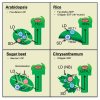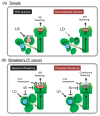Florigen and anti-florigen: flowering regulation in horticultural crops
- PMID: 29681753
- PMCID: PMC5903977
- DOI: 10.1270/jsbbs.17084
Florigen and anti-florigen: flowering regulation in horticultural crops
Abstract
Flowering time regulation has significant effects on the agricultural and horticultural industries. Plants respond to changing environments and produce appropriate floral inducers (florigens) or inhibitors (anti-florigens) that determine flowering time. Recent studies have demonstrated that members of two homologous proteins, FLOWERING LOCUS T (FT) and TERMINAL FLOWER 1 (TFL1), act as florigen and anti-florigen, respectively. Studies in diverse plant species have revealed universal but diverse roles of the FT/TFL1 gene family in many developmental processes. Recent studies in several crop species have revealed that modification of flowering responses, either due to mutations in the florigen/anti-florigen gene itself, or by modulation of the regulatory pathway, is crucial for crop domestication. The FT/TFL1 gene family could be an important potential breeding target in many crop species.
Keywords: FLOWERING LOCUS T (FT); TERMINAL FLOWER 1 (TFL1); anti-florigen; chrysanthemum; florigen; photoperiod.
Figures



Similar articles
-
Constitutive expression of CsGI alters critical night length for flowering by changing the photo-sensitive phase of anti-florigen induction in chrysanthemum.Plant Sci. 2020 Apr;293:110417. doi: 10.1016/j.plantsci.2020.110417. Epub 2020 Jan 22. Plant Sci. 2020. PMID: 32081265
-
The FLOWERING LOCUS T/TERMINAL FLOWER 1 Gene Family: Functional Evolution and Molecular Mechanisms.Mol Plant. 2015 Jul;8(7):983-97. doi: 10.1016/j.molp.2015.01.007. Epub 2015 Jan 15. Mol Plant. 2015. PMID: 25598141 Review.
-
The gated induction system of a systemic floral inhibitor, antiflorigen, determines obligate short-day flowering in chrysanthemums.Proc Natl Acad Sci U S A. 2013 Oct 15;110(42):17137-42. doi: 10.1073/pnas.1307617110. Epub 2013 Sep 30. Proc Natl Acad Sci U S A. 2013. PMID: 24082137 Free PMC article.
-
Functional diversification and molecular mechanisms of FLOWERING LOCUS T/TERMINAL FLOWER 1 family genes in horticultural plants.Mol Hortic. 2022 Aug 16;2(1):19. doi: 10.1186/s43897-022-00039-8. Mol Hortic. 2022. PMID: 37789396 Free PMC article. Review.
-
Evolution and functional diversification of FLOWERING LOCUS T/TERMINAL FLOWER 1 family genes in plants.Semin Cell Dev Biol. 2021 Jan;109:20-30. doi: 10.1016/j.semcdb.2020.05.007. Epub 2020 Jun 2. Semin Cell Dev Biol. 2021. PMID: 32507412 Review.
Cited by
-
AGAMOUS-LIKE 24 senses continuous inductive photoperiod in the inflorescence meristem to promote anthesis in chrysanthemum.Plant Cell. 2024 Oct 3;36(10):4658-4671. doi: 10.1093/plcell/koae235. Plant Cell. 2024. PMID: 39159157 Free PMC article.
-
Regulation of Flowering Time by Environmental Factors in Plants.Plants (Basel). 2023 Oct 25;12(21):3680. doi: 10.3390/plants12213680. Plants (Basel). 2023. PMID: 37960036 Free PMC article. Review.
-
Cherry Blossom Forecast Based on Transcriptome of Floral Organs Approaching Blooming in the Flowering Cherry (Cerasus × yedoensis) Cultivar 'Somei-Yoshino'.Front Plant Sci. 2022 Jan 26;13:802203. doi: 10.3389/fpls.2022.802203. eCollection 2022. Front Plant Sci. 2022. PMID: 35154222 Free PMC article.
-
De Novo Transcriptome Analysis Reveals Flowering-Related Genes That Potentially Contribute to Flowering-Time Control in the Japanese Cultivated Gentian Gentiana triflora.Int J Mol Sci. 2022 Oct 4;23(19):11754. doi: 10.3390/ijms231911754. Int J Mol Sci. 2022. PMID: 36233055 Free PMC article.
-
Translating Flowering Time From Arabidopsis thaliana to Brassicaceae and Asteraceae Crop Species.Plants (Basel). 2018 Dec 16;7(4):111. doi: 10.3390/plants7040111. Plants (Basel). 2018. PMID: 30558374 Free PMC article. Review.
References
-
- Abe, M., Kobayashi, Y., Yamamoto, S., Daimon, Y., Yamaguchi, A., Ikeda, Y., Ichinoki, H., Notaguchi, M., Goto, K. and Araki, T. (2005) FD, a bZIP protein mediating signals from the floral pathway integrator FT at the shoot apex. Science 309: 1052–1056. - PubMed
-
- Abelenda, J.A., Cruz-Oró, E., Franco-Zorrilla, J.M. and Prat, S. (2016) Potato StCONSTANS-like1 suppresses storage organ formation by directly activating the FT-like StSP5G repressor. Curr. Biol. 26: 872–881. - PubMed
-
- Bradley, D., Ratcliffe, O., Vincent, C., Carpenter, R. and Coen, E. (1997) Inflorescence commitment and architecture in Arabidopsis. Science 275: 80–83. - PubMed
Publication types
LinkOut - more resources
Full Text Sources
Other Literature Sources
